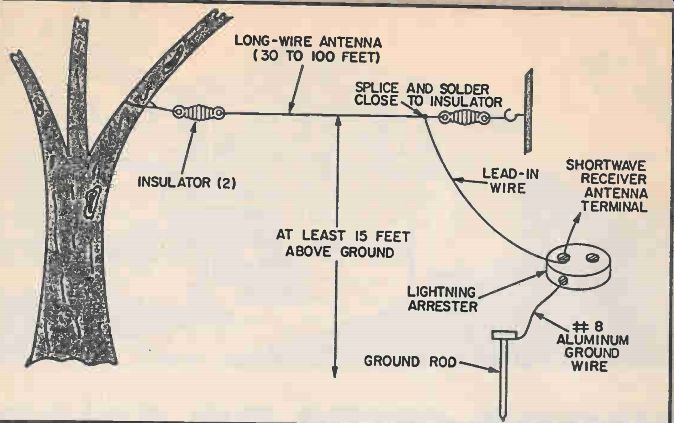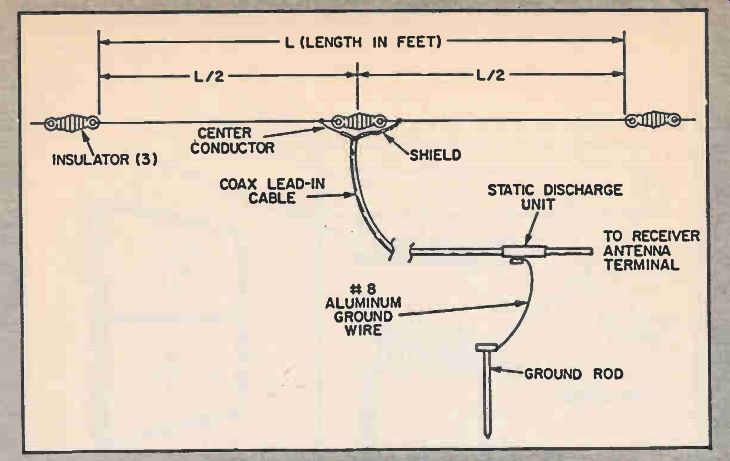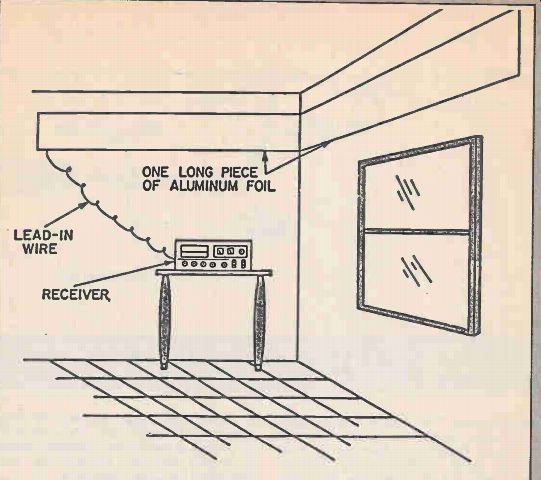
.
It's easy to construct a good shortwave antenna. Just follow these simple directions.
Shortwave listening (SWL) beginners have no problem in finding good receivers, either budget-priced units or gold-plated specials, when starting their first listening shack. Putting up antennas maybe their downfall.
Antenna theory is beyond the grasp of most novices. It is very complex at the beginning and rapidly becomes incomprehensible as different antenna types are introduced. So, why not take a shortcut approach to your first antenna installation.
Get your new receiver pulling weak signals as you pile up listening hours with exotic DXing. What about antenna theory? It'll come if you work at it by reading theory books, but in the meantime here are three recorded case histories on low-cost antenna shortcuts which you can follow.
Case No. 1--The Dangler Harry is a youngster I met while giving a talk to the local high school student body during Science Fair Week. Harry was fascinated by the idea of English language newscasts from far-away places, so he bought a Realistic DX-360 receiver and set up a listening corner in his upstairs room in his folks' Colonial-style house. For an antenna, he dangled an odd length of wire out the window, letting it drop to the ground. The BBC and Radio Moscow came in fine except on rainy nights. In fact, it was a rainy evening when he rang my doorbell for help.
Harry's long wire was long and that's all it had going for it. It was vertically polarized (wrong) by hanging down and shorted out to ground (not good either) on damp nights. What Harry needed was a length of wire extended from the window to a distant pole, out building, garage or tree, In Harry's case, some sturdy trees outlined the house's properly line and he could run a 60-foot antenna with no difficulty. The antenna pointed due North-West and his area of the U.S was able to pull in Europe, North Africa, and the Near East with ease. Here's how we went about licking Harry's problem.

Figure 1. Harry had it made after he put up this simple long-wire antenna.
First, I told Harry that a good long-wire antenna should be 30 to 100 feet long for good reception performance on 2 to 30 megaHertz (MHz). As mentioned earlier, a 60-foot run was possible. A sturdy tree was selected because it hardly swayed in strong winds at the 20-foot level where the antenna would be secured. Some slack (one foot of droop) was left in the antenna to compensate for tree sway and strong winds. Harry's antenna details can be seen in Fig. 1.
Antenna wire and antenna long wire kits are available everywhere. Harry actually used 60 feet of bare copper antenna wire, and 50 feet of lead-in wire.
Harry had no trouble at all getting the antenna up.
Harry was a little smarter than I was. He remembered to protect against lightning. Since shortwave lightning arrester kits are usually not available locally, Harry made do with lightning arrester parts made for TV. The TV arrester has two screw-tight terminals with star washers for the 300 ohm TV line, however Harry only used one for his antenna and the other was left unused. The whole lightning installation kit came to about $10.00. That's cheap. To bring the antenna lead-in into the house, Harry used a "Wall-Thru" tube (Radio Shack 15 1200). Now I don't see much of Harry. Maybe once in a while he's at the Pizza joint with a date, but you can be sure Harry's getting a lot of DXing and mail confirmations every week.
Case No. 2--The Specialist
I've known Mort for over 20 years. We knocked about through high school and somehow the paths of our lives are forever crossing. At one such juncture, Mort invited me to his home to see his new shortwave listening shack which sported a brand-new freshly assembled Heath SW-7800. The SW-7800 is a hot receiver. Unfortunately, I couldn't say the same for Mort's antenna. Mort was always inclined to specialize, and he had rigged up a dipole antenna with 300-ohm TV antenna lead-in wire. Mort wanted to log the 41-meter band and found it offered poor reception in his area. Besides, the noise was too high. He was asking, if not pleading, for advice.
First of all, I told Mort that dipole antennas are cut to exact dimensions for specific frequency bands as shown in Fig. 2. The dipole consists of a wire of a specific length which is cut in half. At the mid-point and both ends, each half of the wire is insulated from each other and insulated from ground. The lead-in cable from the antenna is actually two wires, and it's best to use a 72-ohm coaxial cable (coax) because it is inexpensive and commonly available. Without getting into theory, let me say that a 72-ohm coax lead-in cable "matches" a dipole antenna with less signal loss than does a 300-ohm TV twin-lead cable, On the design board, dipoles have a 75-ohm impedance and match pretty well into 72-ohm coaxes. The 300-ohm cable Mort was using was a bust.

Figure 2. If you want the kind of DX Mort is getting, put up a tuned
dipole antenna.
The equation for determining the overall length for a dipole antenna at a given frequency is determined by dividing the given frequency in kiloHertz into the number 468,000. Or, as seen in the text books: L = 468,000 Where L is the overall length of the dipole in feet and f is the desired reception frequency in kiloHertz (kHz). I computed the overall length for dipole antennas to receive the international shortwave broadcast bands using the mid-frequencies of each and listed them in the Table shown here.
When buying materials for a dipole antenna, the wire and insulators are the same type as required for the long wire antenna. The lead-in coaxial cable should be RG-59/U or RG-11/U, each of which exhibits 72-ohms impedance. Stay away from unknown coax types or those with different impedances (ohms). As a guide, the table lists commonly available coax cables and their impedances. Any coax exhibiting an impedance in the 70's is good for the purpose. Let price dictate your selection.
I did not forget the lightning arrester in Mort's antenna. At the window, out of reach of the rain. I installed a Radio Shack coax static discharge unit (21-1049). This gadget requires a PL-259 connector on the coax lead-in cable. It's worth the trouble. A grounding screw on the connector attaches to the grounding wire and ground rod. An ounce of prevention can save your home.

---------- DIPOLE OVERALL LENGTH FOR THE SHORTWAVE BROADCAST BANDS

Figure 3. How to install an aluminum foil antenna like the one that
set Artie straight.
A dipole has some bonuses. For example, a dipole works equally as well on frequencies three times the designed frequencies. Thus, a 41-meter band dipole which will pull in 7100-7300 kHz signals will also receive 21300-21900 kHz which covers the 13-meter band. Or, if there is sufficient space to string a 195-ft. 2-in, antenna for the 120 meter band (2300-2495 kHz), then you could pull in the 120, 41 and 13 meter bands.
Of course, if you want all the shortwave bands, they're your best bet is a commercial dipole antenna with built-in wave traps.
Don't see much of Mort anymore except at the supermarket. Seems he's a "stay-at-home" type lately. Happy DX-ing. Mort.
Case No.3 - Indoor Antenna
In the third case a friend's son named Artie had caught the short-wave listening bug from a friend in another city. Artie's family lived in an apartment house, and there was no way Artie could rig an antenna up on the roof of the apartment building.
I went over to his family's apartment after his father told me about Artie's problem. He'd already got hold of a good second-hand all-wave receiver, and was using a piece of wire six feet long hooked to the antenna terminal. This picked up lots of local broadcasts, as well as some up to a couple hundred miles away, at night. How to get real DX (long distance) broadcasts? After looking over his situation we borrowed a roll of aluminum foil his mother had in the kitchen, along with some Scotch tape. We ran it all along one wall near the ceiling, starting near the receiver, and also along a second wall, as shown in Figure 3. Artie has been logging overseas stations on most bands on his receiver ever since, and now he's looking at a brand new, super-sensitive all-wave receiver.
For the lead-in wire we just used the ordinary hookup wire (number 18 to 24 will do) Artie had been using for his antenna before I visited him. Connecting the receiver's ground terminal to a radiator helped bring in more stations, too.
Editor's Note: If you have difficulty locating good antenna wire and lead in, write to Heath Company for their Longwire SWL antenna package. It's 75-feet long with 30 feet of lead in and includes all insulators and hardware. Item GRA 72, $14.95.
Heath is at Benton Harbor, MI 49022.
Also see: Electronics Handbook subscription ad / Welcome Aboard / Writers Wanted
More from EH magazine: Tandy's Radio Shack
Adapted from: Electronics Handbook--Spring 1987